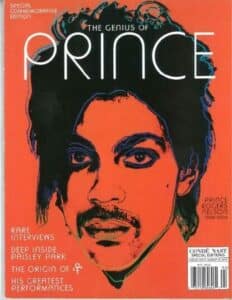Table of Contents
Background
On May 18, 2023, the U.S. Supreme Court ruled 7-2 against the Andy Warhol Foundation for the Visual Arts over whether Warhol’s use of a photo of the musician Prince by Lynn Goldsmith in one of his art pieces constituted copyright infringement. This decision, after almost six years, has been eagerly awaited by the arts community.
The photographer claimed that the late Andy Warhol illegally used her photo of Prince in his “Prince Series,” which he created in 1984. This was a set of 16 silk-screen prints of the rock star’s face done in various colour schemes.
Warhol created this series as an assignment for Vanity Fair. At that time, the parent company of Vanity Fair (Conde Nast) had paid Goldsmith $400USD to licence her photo for one-time use. A reproduction of one of Warhol’s prints (called “Purple Fame“) was published in the magazine, and Goldsmith was given an attribution for the photo.
The Lawsuit and the Appeal
She decided to sue after Vanity Fair published a second piece from Warhol’s series called “Orange Prince.” This series of prints was copyrighted by Warhol, and have been reproduced and sold for $100s of millions. They were featured as part of a commemorative issue published by Conde Nast following Prince’s death in 2016. The magazine paid the Warhol Foundation $10,000USD to use the image, but did not compensate or credit Goldsmith. She stated that Warhol had not sought permission to use her photo for the 16-part series, nor did he offer her any compensation or provide any attribution.

A New York federal district judge ruled in favour of Andy Warhol because he felt that the artist’s work was sufficiently transformative, and fell within the realm of “fair use.” However, Goldsmith appealed the ruling. In his decision, Judge Gerard Lynch (U.S. Court of Appeals for the Second Circuit) wrote, “The district judge should not assume the role of art critic and seek to ascertain the intent behind or meaning of the works at issue …. because judges are typically unsuited to make aesthetic judgements and because such perceptions are inherently subjective.” As a result, she was able to relaunch her lawsuit, and it was brought before the U.S. Supreme Court.
U.S. Supreme Court Justice Sonia Sotomayor noted in the majority opinion that, “Lynn Goldsmith’s original works, like those of other photographers, are entitled to copyright protection, even against famous artists.“
Consequences for Artists
This case has been carefully monitored by the arts community because it is anticipated to have far-reaching consequences for artists whose work is based on copying and transforming.
If an artist does transformative work and is sued, the most commonly used defence is exactly that – the work is “transformative.” In other words the claim is that the original copyrighted work has been “transformed” by the artist to such an extent that new meaning or character is now present.
In this lawsuit, Goldsmith argued that Warhol’s use was not transformative. She felt that Warhol’s print was demonstrably her photograph, and that no new meaning was created.
Some have argued that artists regularly reference and copy each other’s work. Regarding photographs, artists argue that they are the documentation of contemporary cultural life. By using existing photographs or videos, an artist’s work can directly incorporate and interpret this record. This lets them be relevant by commenting on the imagery of our time. Many artists use an exact (or nearly exact) replication of the original photograph to convey their artistic message. It must then be determined if there has been sufficient other imagery or components added to create an entirely new statement from that which the photographer made with the original image (this is also an art form).
The other key take-away is whether the reference photo an artist uses has been copyrighted by the photographer, and if it requires licencing for use. This issue likely had a large bearing on the court’s decision, especially since there didn’t appear to them to be any significant transformation – the prints and the photograph seemed to the court to be clearly the same image.
A Related Case
This decision came shortly after another court ruled that two lawsuits launched against the noted appropriation artist Richard Prince could go ahead. These cases involve the artist’s unauthorised use of Instagram photos, and also centre on the concepts of fair use and transformation.
I’ll keep my eye on these suits, and report back in another article.




